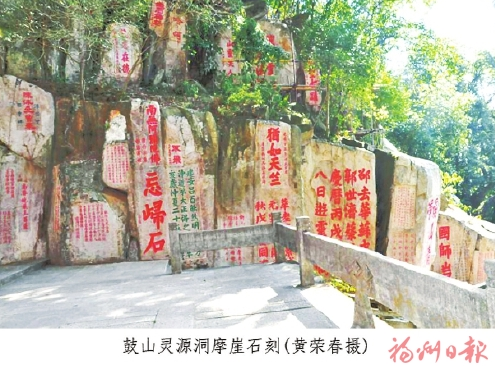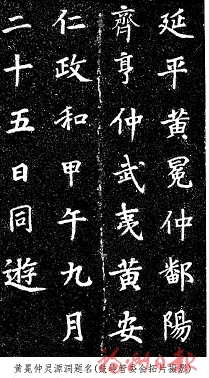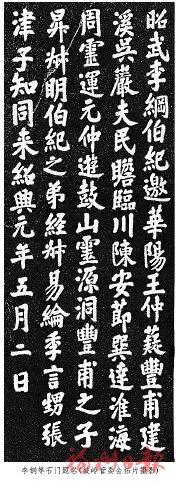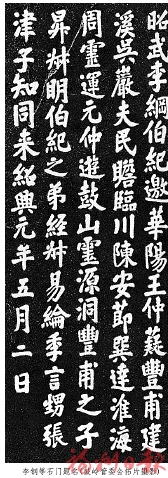Mount Gushan Cliff Carvings--Treasure House of Chinese Calligraphy Art
2020-05-03 11:57:45
Reported by Wu Hui
2020.05.03
May 3, 2020

Mount Gushan Cliff Inscriptions (Photograph by Huang Rongchun)

Mount Gushan Cliff Inscriptions -- Treasure House of Chinese Calligraphy Art

Rubbings of autographs by Huang Mianzhong and others at Lingyuan Cave. (Photograph by Guling Scenic Area Administrative Committee)

Rubbings of autographs by Li Gang and others at Shimen. (Photograph by Guling Scenic Area Administrative Committee)
FUZHOU, May 3 (Fuzhou Daily) – Cliff inscriptions, one of the ancient Chinese stone carving arts, refer to the calligraphy works, statues or rock paintings carved on the cliffs and rocks, which were very popular during the Northern Song Dynasty. More than 1,480 pieces of cliff inscriptions in the urban area of Fuzhou constitute an important part of Fuzhou as a historical and cultural city. The largest number of cliff inscriptions in Fuzhou, as many as 700 pieces, can be found on Mount Gushan, covering the periods from the Northern Song Dynasty to the present day. It is a treasure house of Chinese calligraphy art and has important historical, artistic, and scientific value. In 2001, Mount Gushan Cliff Inscriptions were listed by the State Council as a key monument protected at the national level.
Discoveries
Since the Song Dynasty, many officials and tourists have inscribed words and texts on the cliffs of Lingyuan Cave, Baiyun Cave, Dharma(an ancient Indian saint) Eighteen Scenes, Shideng Road, Sarira Cave, Guling, Shanxi Creek, Moxi Creek and other places. There were originally 711 pieces of cliff inscriptions in Mount Gushan Scenic Area and only 652 pieces have survived with 59 pieces missing.
Tracing to historical origin
Many historical celebrities left their calligraphy works here.
Narrated by Huang Rongchun, research fellow of cultural relics and museology
Mount Gushan Cliff Inscriptions started to appear in the Northern Song Dynasty and extended to the contemporary period. Surviving cliff inscriptions can be attributable to the following personages:
Song Dynasty:
Zhao Ruyu (1140-1196) and Li Gang (1083-1140), Prime Ministers; Zhen Dexiu (1178-1235) and Chang Ting (1205-1270), Deputy Prime Ministers; Zhang Zhen, Minister of Personnel; Hu Ju (1163-1244), Minister of Works; Huang Shang (1044-1130), Number One Scholar (title conferred on the one who came first in the highest) and later Minister of Rituals; Zhu Xi (1130-1200), a famous thinker of Neo-Confucianism; Cai Xiang (1012-1067), a calligrapher and Fuzhou Governor;
Yuan Dynasty:
Dorjbal (1315-1354), manager of governmental affairs; Jiao Deyu (1219-1288), Duke of Heng State; Wang Han (1333-1378), Director of Fujian Administrative Province; Xue Chaowu, Number One Scholar; and Zheng Zhi, Deputy Envoy of Regional Investigation Office of Minhai (Fujian and Hainan) Prefecture;
Ming Dynasty:
Wang Ao (1384-1467), Minister of Personnel; Guo Rulin (1510-1580) and Chen Kan, envoys to the Ryukyu Kingdom; Gong Yongqing, Number One Scholar; Zhou Yi, Tu Qiao (1480-1555) and Xu Qianjian, administrative commissioners of Fujian Province; and Chen Dao, Garrison Eunuch of Fujian Province;
Qing Dynasty:
Li Shuaitai (1608-1666), Viceroy of Fujian and Zhejiang Provinces; Tong Guomi and Huang Guocai, Governors of Fujian Province; Chen Baochen (1848-1935), Taishi and Taifu (prime minister); Cheng Ji and Chang Qing, General of Fuzhou; Shen Baozhen (1820-1879), Minister of Shipping; and Su Tingyu (1783-1852), Governor of Sichuan Province;
Republic of China:
Sun Chuanfang (1885-1935), a Beiyang warlord and leader of the League of Eight Provinces (Southern Zhili Clique), based in Nanjing.
The cliff inscriptions of poems, autographs and “bangshu” calligraphy by Zheng Zhaoxian (1158-1225), Prime Minister of the Song Dynasty and Wang Yinghu, Vice-General of the Qing Dynasty, among others, are missing.
The following transcripts are the most famous pieces of cliff inscriptions:
The autograph by Huang Mianzhong (or Huang Shang), Scholar of Duanming Palace of the Royal Court and the Minister of Rituals, and his companies of the Northern Song Dynasty: “Huang Mianzhong of Yanping City, Qi Hengzhong of Poyang City, and Huang Anren of Wuyi City are here on the 25th day of the ninth lunar month in the fourth year of Zhenghe Period during Emperor Huizong’s Reign (of the Song Dynasty) (i.e. Year 1114)”.
The autograph by Li Gang and his companies at Shimen: “Li Gang (courtesy name: Boji) of Zhaowu City invited Wang Zhongyi (courtesy name: Fengfu) of Huayang City, Wu Yanfu (courtesy name: Minzhan) of Jianxi City, Chen Anjie (courtesy name: Xunda) of Linchuan City, Zhou Lingyun (courtesy name: Yuanzhong) of Huaihai City to visit Lingyuan Cave of Gushan Mountain. In our company are Wang Sheng (courtesy name: Shuming), the son of Wang Fengfu, Li Jing (courtesy name: Shuyi) and Li Lun (courtesy name: Jiyan), the younger brothers of Li Boji, and Zhang Jin and Zhang Zizhi, the nephews of Li Boji. On the second day of the fifth lunar month in the first year of Shaoxing Period during Emperor Gaozong’s Reign (of the Song Dynasty) (i.e. Year 1131)”.
The poem by Zhao Zizhi (1140-1196, given name: Ruyu, highest rank: Prime Minister) carved on stone at Shimen: “I feel covered with dust after running errands for the emperor for a few years, but I experience a great relief standing here. The moon above the river does not flow away with the water, but the celestial wind has brought the sea tide-shaped clouds before me. The missing is strong when old friends are long separated, but things have changed a lot after long parting. I sigh as this is inevitable for many people, and I am worried about the fate of humankind leaning against the stone rails here.”
The four-character inscription of “celestial wind sea tide” by Zhu Xi at Lize Peak was drawn from Zhao Zizhi’s poetic line of “the celestial wind has brought the sea tide-shaped clouds before me”. There is the inscription of Zhu Xi at Shimen: “In the fourteenth year of Chunxi Period during Emperor Xiaozong’s Reign (of the Song Dynasty) (i.e. Year 1187), I (Zhu Xi, courtesy name: Huiweng) come to Gushan Mountain to pay my respect to Yuansi the Buddhist Abbot, tour Lingyuan, climb to Shuiyun Pavilion and recall the previous visit of Zhao Zizhi, the Assistant Minister from Sichuan. In my company are Wang Zihe of Qingzhang City, Chen Fuzhong, Pan Qianzhi and Huang Zifang, all being local residents, and Duanyou the monk”.
The inscription of Zhu Xi at Lingyuan Cave: “Shou (i.e. longevity). Huiweng.” “Huiweng” is the courtesy name of Zhu Xi and the character “Shou (i.e. longevity)” is 4.15 meters high and 3.05 meters wide.
The autograph by Xue Chaowu (Number One Scholar in the fourteenth year of Zhizheng Period during Emperor Huizong’s Reign (i.e. Year 1354)) and his companies on the side of Banshan Pavilion: “On the first day of the eighth lunar month (autumn) in the twenty-fifth year of Zhizheng Period during Emperor Huizong’s Reign (of the Yuan Dynasty) (i.e. Year 1365), Xue Chaowu of Liaodong City (i.e. eastern Liaoning), Wang Yongwen of Lingwu City, Li Junxian of Jinan City and Hu Wen of Kuaiji City are here.”
The autograph by Xie Zhaozhe (1567-1624) on the east side of Longtou Spring: “Xie Zhaozhe is here in the autumn of the thirty-sixth year of Wanli Period during Emperor Shenzong’s Reign (of the Ming Dynasty) (i.e. Year 1608)”. Xie Zhaozhe, a successful candidate in the highest imperial examinations in the twentieth year of Wanli Period during Emperor Shenzong’s Reign (of the Ming Dynasty) (i.e. Year 1592), served as Prefecture Judge of Huzhou Prefecture, and was later promoted to Director of the Ministry of Works and finally resigned from the post of Administrative Commissioner in Guangxi. Xie, a brilliant man of wide learning, was good at writing poems and essays and his works included “Five Miscellaneous Morsels”.
The “bangshu” calligraphy by Su Tingyu (1783-1852) on the east side of Gengyi Pavilion: “Renowned Mountain in Ancient and Modern Times. Inscribed by Su Tingyu of Tong’an City in the twenty-sixth year of Daoguang Period during Emperor Xuanzong’s Reign (of the Qing Dynasty) (i.e. Year 1846).” Su Tingyu, a successful candidate in the highest imperial examinations in the nineteenth year of Daoguang Period during Emperor Xuanzong’s Reign (of the Qing Dynasty) (i.e. Year 1814), served as the Governor of Sichuan and was responsible for training aristocrats and civilians into strong soldiers at Wuhumen of Fuzhou during the Opium War period. His works included the “Treasure Writings of Yijia Study”.
Protection and Inheritance
Implementing protection projects by stages
After the founding of the People’s Republic of China, the authorities adopted protective measures for Mount Gushan Cliff Inscriptions. In 1961, Mount Gushan Cliff Inscriptions were listed as a monument protected at the provincial level. In 1991, the Garden Management Office of Mount Gushan Scenic Area was established to manage and protect Mount Gushan Cliff Inscriptions.
Starting from September 2017, the Guling Scenic Area Administrative Committee started to launch a three-phase protection works for the Gushan Cliff Inscriptions: The Phase-I protection works, covering an area of about 600 square meters, provided maintenance services to more than 390 pieces of the Cliff Inscriptions around the 18 cliff murals and Lingyuan Cave of Gushan Mountain; the Phase-II protection works, covering an area of nearly 400 square meters, provided protection and maintenance services to 215 pieces of Cliff Inscriptions in the 18 cliff murals, Baiyun Cave at Fengchi Lake, Lize Peak, Shanxi Creek, and Moxi Creek; and the Phase-III protection works was to turn the Cliff Inscriptions into a cultural and creative service project. Professional contingents shall be employed to take rubbings of the representative inscriptions, with the total area of rubbings reaching 250 square meters, digitize them, and compile the rubbings and texts into the “100 Selected Rubbings of Mount Gushan Cliff Inscriptions” for publication.
Experts Comment
Lin Shan, an expert in literature and history and executive vice-chairman of Fuzhou Culture Research Association
Mount Gushan is the most famous historical and cultural mountain in Fuzhou and a key national scenic area. Hundreds of cliff inscriptions of different fonts such as Kai-font, Xing-font, Cao-font, Li-font, and Zhuan-font were left by celebrities of all dynasties. Mount Gushan, which might also be called the “Forest of Stone Steles in Southeast China”, is a key monument protected at the national level just as the “Forest of Stone Steles” in Xi’an of Shaanxi Province.
The value of the “Mount Gushan Cliff Inscriptions” lies in the fact that it is both world cultural heritage and world natural heritage, which makes it more attractive than Xi’an Forest of Stone Steles.
The “Mount Gushan Cliff Inscriptions” is one of the treasure houses of Han-nationality culture and art displaying the most stone carvings of celebrities. It is of great historical and artistic value as a venue for cliff inscriptions of Chinese magnates and literati of different dynasties as well as a gathering place for famous calligraphy works and art treasures of all dynasties. The legendary stories of celebrities, outstanding calligraphy art, and rich cultural connotations have made the “Mount Gushan Cliff Inscriptions” a treasure house of oriental culture, a refuge for Chinese calligraphy art, and the world’s most natural treasure house of stone carving works.